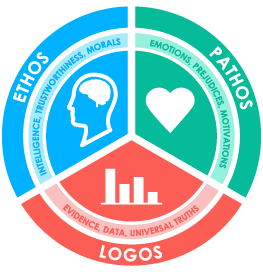<< Hide Menu
What is the definition of rhetoric?
3 min read•july 11, 2024
What is rhetoric? 📝
Rhetoric is the art of persuasion. It began nearly 2,500 years ago in Ancient Greece when it was used by great philosophers like Aristotle. The word itself is derived from the Greek rhetorike, which means the "art of speech." 🏺 🇬🇷
Thus, rhetoric refers to the study and uses of both the written and spoken word. This critical pillar of communication and argumentation is still in use today and will appear constantly as you make your way through AP Lang. Want some practice? Check out this 🎥 video on Rhetoric Analysis frqs problems and review with this study guide of an Overview of Rhetorical Analysis!
What is Rhetorical Situation? 📚
Rhetorical situation is the reason why you write, who you write to, and what you want them to know! It has three main parts:
- Exigence: what promoted an author to write. ✍️
- Audience: who the author is writing to. 👥
- Purpose: what the author is trying to convey to the reader. ❗
What are Rhetorical Appeals? 💡
Following the rhetorical situation are the rhetorical appeals - methods of persuasion used by the speaker or author to convince the audience of their argument. Often, these ethical strategies are formatted into what is known as Aristotle's Rhetorical Triangle. 🔺
The three rhetorical appeals are listed below, for more information watch Fiveable's 🎥 video on the Rhetorical Triangle!

(Image Courtesy of storyboardthat.com)
- Ethos: evidence of an author's credibility. 👩🎓
- Logos: an author's use of facts and logical supporting evidence. 📊
- Pathos: the author's use of passion and emotion. 🗣️ ❤️
What are the Eight Patterns/Strategies of Rhetoric? 🧠
Rhetoric has eight main patterns or strategies:
-
Cause/Effect: as a result of "A," "B" occurs.
-
Compare/Contrast: analysis of similarities and differences.
-
Composition/Division: the process of grouping from specific to general or from small groups to large groups.
-
Definition: denotative or connotative; usually includes class or group in which it belongs and how it is different from all other categories.
-
Description: aims to create a visual appeal with imagery.
-
Exemplification: the writer uses examples to illustrate, support, and clarify an argument via samples, detail, person, typical event or a specific organizational pattern such as chronological, spatial, or most important to least important.
-
Narration: tells a story meant to entertain or support a moral principle.
-
Process Analysis: step-by-step instructions explaining functionality or how to perform a task. ✏️ These patterns are accompanied by surface features - patterns of development:
-
Diction: word choice; includes trope (figurative language) such as personification, simile, and metaphor.
-
Syntax: sentence structuring. (periodic sentence, simple coordinate conj., etc.)
-
Bridge Techniques: a combination of diction and syntax like an antithesis or antimetabole. Best of luck this year. Once you've mastered rhetoric and its subsequent parts, you will be an AP Lang champ! 🏆
For more information: Visit the College Board's AP Lang Course Description

© 2025 Fiveable Inc. All rights reserved.